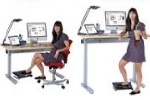At the beginning of the year I wrote a blog about standing desks following an article I had read, ‘sitting is the new smoking’. The team loved the idea of standing desks and the benefits that are said to be linked to them. We are now the proud owners of five custom built standing desks. We decided to keep one desk as a sitting desk. Each desk is ergonomically designed so that they’re at the correct height and working position for everyone. Kirsty is so much taller than me that when I stand next to her desk I feel like Alice in Wonderland after drinking the potion that made her smaller!

The team are still getting used to the desks and we know it’ll take a while. We are experimenting with the best shoes to wear (gone are our beloved high heels) and we’re getting some fatigue mats to help cushion our feet. Anh and Chloe prefer to perch on their stools fairly often or change to a sitting desk whereas Kirsty, Lauren and I would rather stand for a bit longer. We all have comfortable adjustable height perch stools which mean we can work at the right height when we sit, but they can be stowed under the desk when we’re standing.
It is too early to tell whether or not the team are reaping any rewards, although both Kirsty and Lauren have commented that their daily steps have slightly increased compared to when they were sitting down for most of the day. Perhaps it’s because when you’re standing you are more likely to move around.
A typical office worker will spend an average of 10-12 hours’ sitting each day, a mixture of sitting behind a desk, commuting to work or watching TV. If you add sleeping into the mix, it emerges that we are only on our feet for very few hours a day.
There are a number of risks associated with prolonged periods of inactivity. Obesity, high blood pressure and an increase in the risk of type two diabetes are a few of the most common health risks. As soon as you sit down the electrical activity in the leg muscles shuts off, calorie burning drops to one per minute and enzymes that help break down fat drop 90%. After two hours good cholesterol drops by 20%. Who’d have thought sitting down could do so much harm?
Staying in any position – whether sitting or standing - for too long isn’t healthy. Standing may be healthier but standing for long periods of time is associated with lower back pain, sore feet, swollen legs, stiff necks, cardiovascular problems and varicose veins. Don’t over-do it.
If you decide to change to standing desks as we have, allow yourself time to adjust. New standing desk users should gradually ease into working in a standing position to allow the body to adapt. Public Health England guidelines published last year suggest that you should begin with two hours of standing a day, eventually progressing to around four hours. The jury’s out as to whether this should be continuous standing or short bursts throughout the day. The best advice is listen to your body.
The guidelines also suggest regular breaks and around two hours of light activity during working hours. Every 45 minutes or so get up and move for a period of three or four minutes. Avoid prolonged static standing postures.
We’re quite excited about going to sit-stand mode, but we accept that we a gradual transition is desirable, we may need to add in additional adjustments such as foot stools and keep monitoring to make sure everyone’s comfortable and no health issues are emerging.
We deal with the good, the bad and the ugly of HR. If you need help resolving problems with couch potato employees or any other HR issues, give us a call on 01908 262628.
Signed up for our free resources and free weekly tip yet? Register and subscribe here.
Russell HR Consulting provides expert knowledge in HR solutions, employment law training and HR tools and resources to businesses across the UK.
Subscribe to our free monthly HR newsletter. Russell HR Consulting employment law newsletters are emailed automatically to our ever-growing number of subscribers every month.
Latest blog posts
- Is There a Santa Clause?
06 / 12 / 2023
- Lend Us a Hand!
22 / 11 / 2023
- What Happens When There is a Clash in Protected Characteristics?
17 / 10 / 2023
- Encouraging a Healthy Workforce 2
21 / 09 / 2023
- Encouraging a Healthy Workforce
23 / 08 / 2023
- What a Disaster - (But We Have a Cunning Plan!)
20 / 07 / 2023
- It’s Time We Stiffened the Sinews
14 / 06 / 2023
- Why Is It So Important to Develop Emotional Resilience?
16 / 05 / 2023
- When is a discretionary bonus not discretionary?
20 / 04 / 2023
- Recovering Training Costs 15 / 03 / 2023
